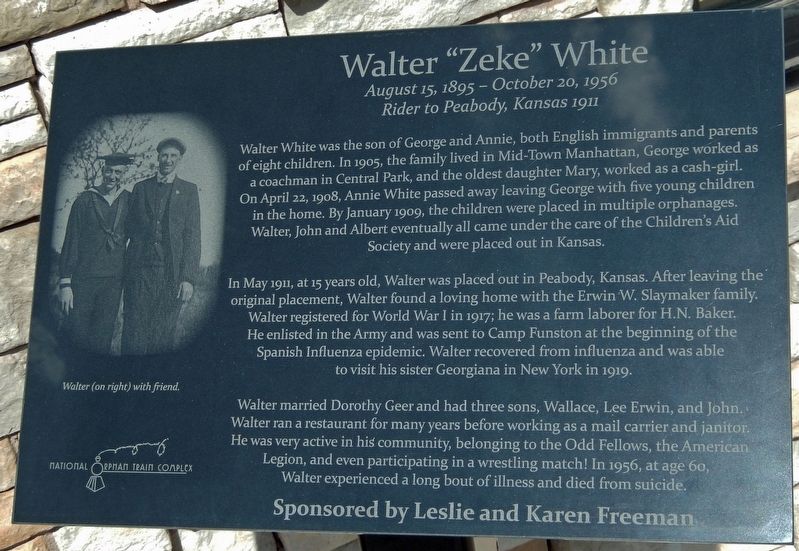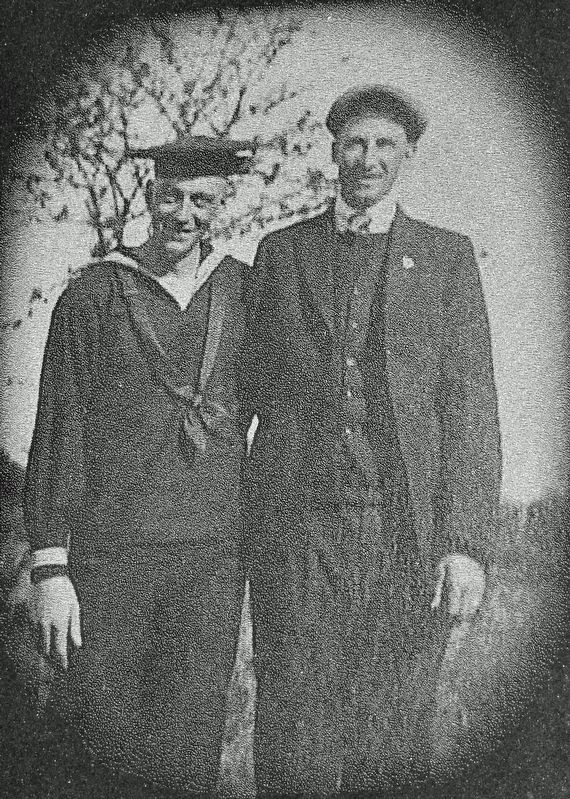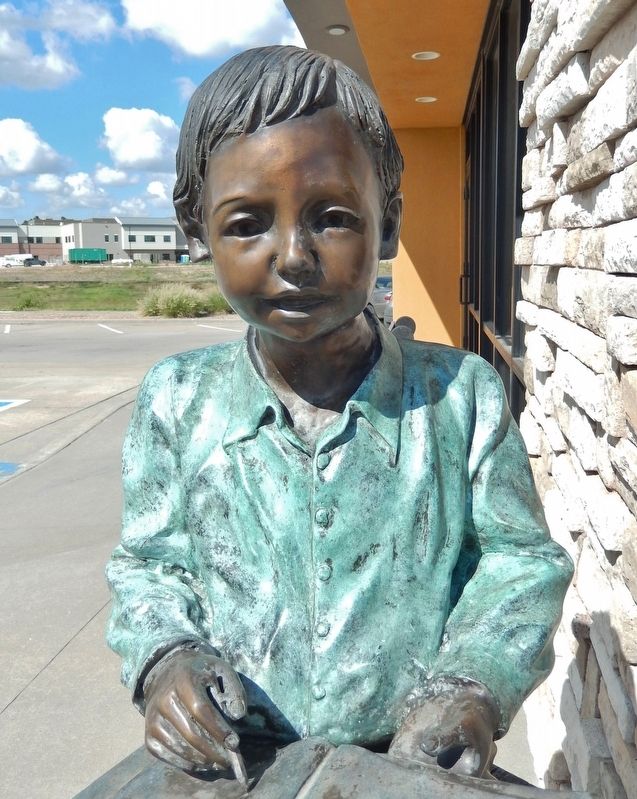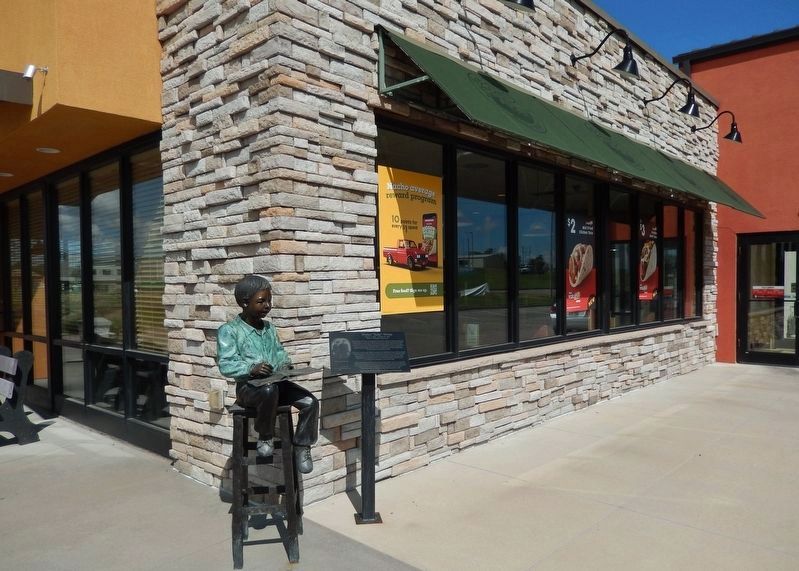Concordia in Cloud County, Kansas — The American Midwest (Upper Plains)
Walter "Zeke" White
August 15, 1895 - October 20, 1956
— Rider to Peabody, Kansas 1911 —
Walter White was the son of George and Annie, both English immigrants and parents of eight children. In 1905, the family lived in Mid-Town Manhattan, George worked as a coachman in Central Park, and the oldest daughter Mary, worked as a cash-girl. On April 22, 1908, Annie White passed away leaving George with five young children in the home. By January 1909, the children were placed in multiple orphanages. Walter, John and Albert eventually all came under the care of the Children's Aid Society and were placed out in Kansas.
In May 1911, at 15 years old, Walter was placed out in Peabody, Kansas. After leaving the original placement, Walter found a loving home with the Erwin W. Slaymaker family. Walter registered for World War I in 1917; he was a farm laborer for H.N. Baker. He enlisted in the Army and was sent to Camp Funston at the beginning of the Spanish Influenza epidemic. Walter recovered from influenza and was able to visit his sister Georgiana in New York in 1919.
Walter married Dorothy Geer and had three sons, Wallace, Lee Erwin, and John. Walter ran a restaurant for many years before working as a mail carrier and janitor. He was very active in his community, belonging to the Odd Fellows, the American Legion, and even participating in a wrestling match! In 1956, at age 60, Walter experienced a long bout of illness and died from suicide.
Erected 2019 by National Orphan Train Complex; and Leslie and Karen Freeman.
Topics. This historical marker is listed in these topic lists: Charity & Public Work • Fraternal or Sororal Organizations • Immigration • War, World I. A significant historical month for this entry is May 1911.
Location. 39° 33.334′ N, 97° 39.471′ W. Marker is in Concordia, Kansas, in Cloud County. Marker can be reached from Lincoln Street (U.S. 81) 0.2 miles south of East 20th Street, on the right when traveling south. Marker and sculpture are located at the southeast corner of the Taco John's building. Touch for map. Marker is at or near this postal address: 2122 Lincoln Street, Concordia KS 66901, United States of America. Touch for directions.
Other nearby markers. At least 8 other markers are within walking distance of this marker. Davies-Crook American Legion Post 76 War Memorial (approx. 0.4 miles away); Civil War Soldiers and Sailors Memorial (approx. 0.4 miles away); James Manny Hagaman (approx. 0.4 miles away); World Wars Memorial (approx. half a mile away); Kansas Orphan Riders (approx. 0.6 miles away); Gertrude Vale / Sister Eva Marie Vale (approx. 0.6 miles away); Genevieve Hunt / Sister Roberta Dreiling (approx. 0.6 miles away); Cloud County War Memorial (approx. 0.7 miles away). Touch for a list and map of all markers in Concordia.
Related markers. Click here for a list of markers that are related to this marker. Orphan Train Movement
Also see . . .
1. Walter Elliott “Zeke” White (Find A Grave).
New York Pvt. 4 Co. 164 Depot Brig. WW I(Submitted on December 15, 2022, by Cosmos Mariner of Cape Canaveral, Florida.)
2. A History of the Orphan Trains.
When the Orphan Train movement began, in the mid-19th century, it was estimated that approximately 30,000 abandoned children were living on the streets of New York. Over the 75 year span of the Orphan Train movement, it is estimated that between 150,000 and 200,000 children were relocated to new homes via the Orphan Trains.(Submitted on December 15, 2022, by Cosmos Mariner of Cape Canaveral, Florida.)
3. An Orphan Train Rider’s story.
From approximately 1854 to 1929, the “Greatest American Migration” took place. Upward of 250,000 children were displaced from their homes on the East Coast, mostly from New York City, and sent to every state in the union, but mostly to the Midwest, in what has come to be called the orphan train movement. It displaced more children than any other movement in world history. The children were homeless, vagrant children or were from the local orphanages. They were sent westward by primarily the Children’s Aid Society, through the work of the Rev. Charles Loring Brace, or by the New York Foundling Hospital. Some of the children found good, loving foster homes. Others entered abusive environments, or were used as farm or domestic labor.(Submitted on December 15, 2022, by Cosmos Mariner of Cape Canaveral, Florida.)
Credits. This page was last revised on December 24, 2022. It was originally submitted on December 15, 2022, by Cosmos Mariner of Cape Canaveral, Florida. This page has been viewed 105 times since then and 21 times this year. Photos: 1, 2, 3, 4. submitted on December 15, 2022, by Cosmos Mariner of Cape Canaveral, Florida.



